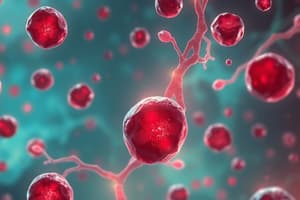Podcast
Questions and Answers
What is a potential cause of aplastic anemia?
What is a potential cause of aplastic anemia?
- Excessive red blood cell production
- Low white blood cell count
- Autoimmune response (correct)
- High platelet count
What is a recommended treatment for aplastic anemia?
What is a recommended treatment for aplastic anemia?
- Stem cell transplants and immunosuppressant pretreatment (correct)
- Whole blood transfusions only
- Antibiotic therapy
- High-dose iron therapy
What is the recommended dosing for ferrous sulfate in oral iron therapy?
What is the recommended dosing for ferrous sulfate in oral iron therapy?
- 324 mg po BID
- 150 mg po qd
- 324 mg po TID
- 325 mg po TID (correct)
How long should iron therapy continue after resolving anemia to prevent relapse?
How long should iron therapy continue after resolving anemia to prevent relapse?
What should be avoided to increase iron absorption during therapy?
What should be avoided to increase iron absorption during therapy?
What is primary closure in wound management?
What is primary closure in wound management?
When is secondary intention wound closure considered?
When is secondary intention wound closure considered?
What characterizes tertiary closure (delayed primary) in wound management?
What characterizes tertiary closure (delayed primary) in wound management?
What is the outcome of allowing a wound to heal through secondary intention?
What is the outcome of allowing a wound to heal through secondary intention?
When is primary closure not employed in wound management?
When is primary closure not employed in wound management?
Flashcards are hidden until you start studying
Study Notes
Aplastic Anemia
- Exposure to toxic chemicals, radiation, and certain medications can cause aplastic anemia
- Bone marrow transplantation is a recommended treatment for aplastic anemia
Oral Iron Therapy
- The recommended dosing for ferrous sulfate in oral iron therapy is 300mg 1-2 times daily
- Iron therapy should continue for 6-12 months after resolving anemia to prevent relapse
Iron Absorption
- Antacids, calcium, and milk should be avoided to increase iron absorption during therapy
- Vitamin C can enhance iron absorption
Wound Management
- Primary closure is a wound closure technique where the wound is closed immediately after surgery or injury
- Secondary intention wound closure is considered when the wound is contaminated, has a high risk of infection, or is not suitable for primary closure
- Tertiary closure (delayed primary) is characterized by a delay in wound closure until the wound is clean and free of infection
- Allowing a wound to heal through secondary intention can lead to the formation of granulation tissue and a longer healing time
- Primary closure is not employed in wound management when the wound is contaminated, has a high risk of infection, or is not suitable for closure
Studying That Suits You
Use AI to generate personalized quizzes and flashcards to suit your learning preferences.



